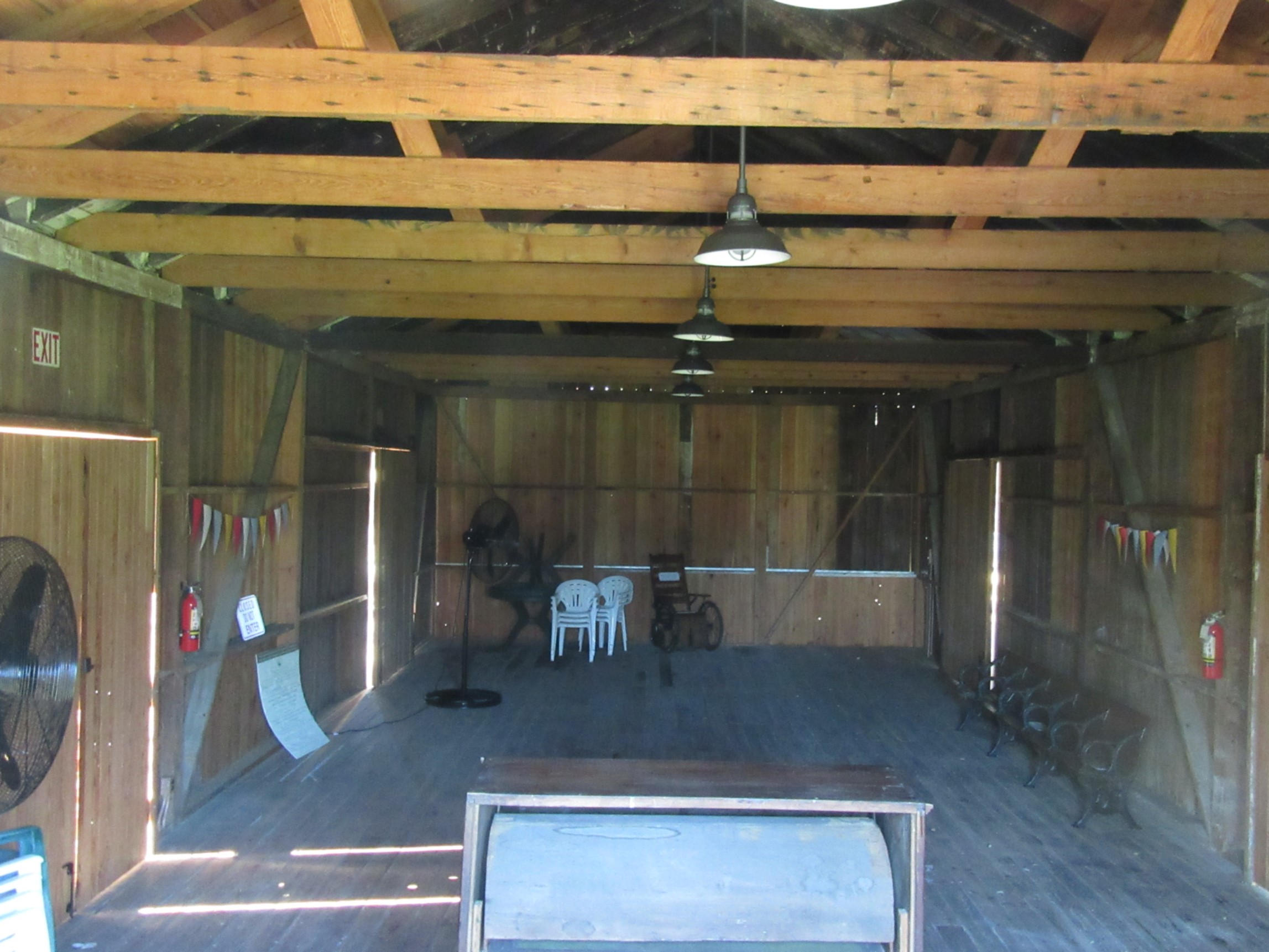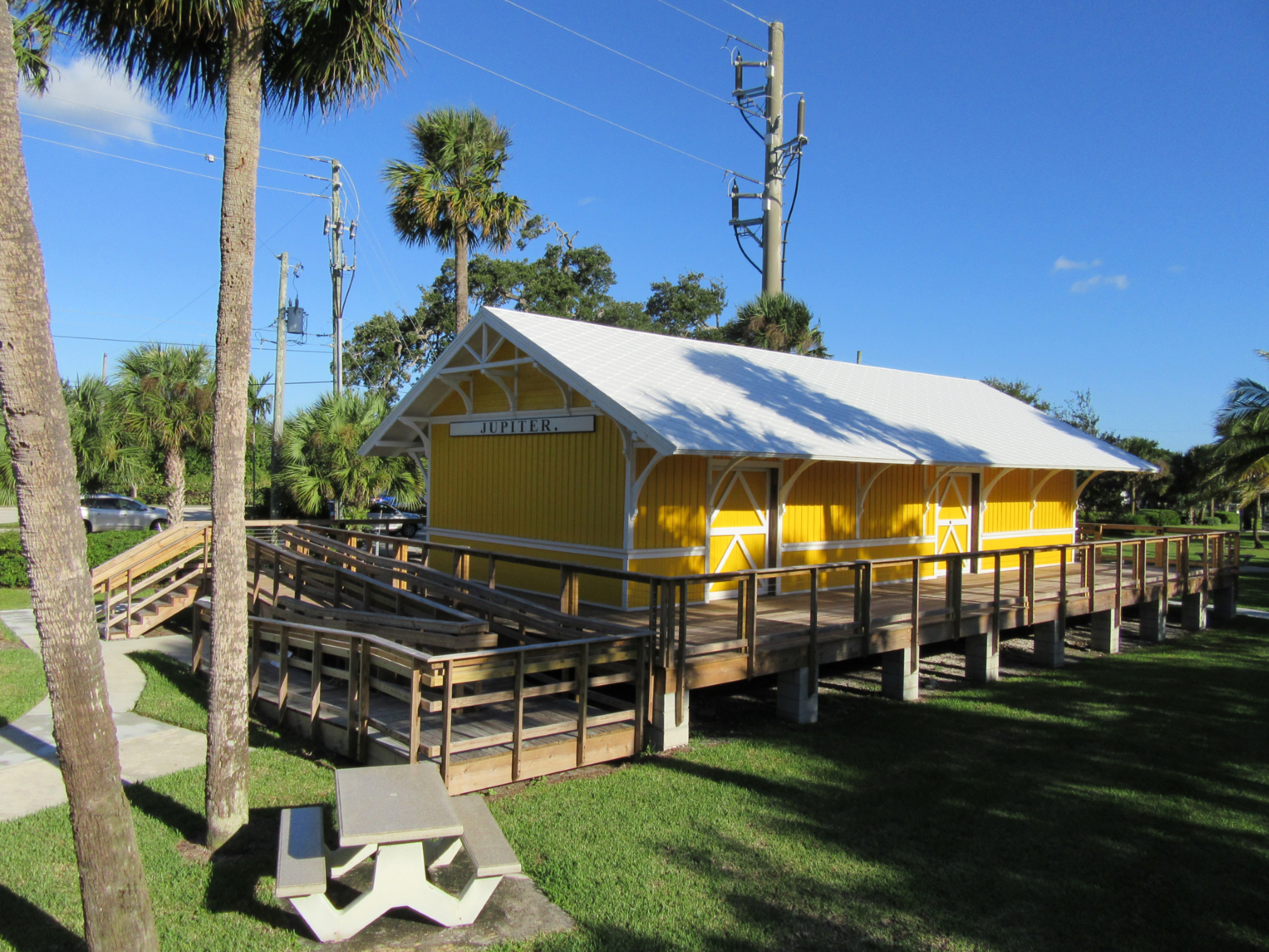By John Curtin Home Inspector
Content Approved and Protected
Did you ever wonder what that Yellow Building was on the side of A1A in Sawfish Park just south of the Loxahatchee River?
 Oil tycoon and business partner of the Rockefellers, Henry Flagler’s first visit to Jacksonville, Florida in the 1870’s was uneventful, he had been requested to visit a warmer climate due to the serious illness of his first wife. After his wife passed and he remarried, he again spent some time in northern Florida, this time St. Augustine, but again found he was bored because there was very little to see and do, and few ways to travel in the state outside of horse, buggy and canoe! Bent on changing that, Flagler became the grandfather of Florida’s Railroad movement, and his efforts gave shape to the Florida East Coast Railroad. The businessman quickly realized that his dreams of opening a series of hotels in the state would require a more solid form of transportation, and he quickly purchased a handful of short line railroads, modernizing and updating them to ensure they could handle current and future transportation demands.
Oil tycoon and business partner of the Rockefellers, Henry Flagler’s first visit to Jacksonville, Florida in the 1870’s was uneventful, he had been requested to visit a warmer climate due to the serious illness of his first wife. After his wife passed and he remarried, he again spent some time in northern Florida, this time St. Augustine, but again found he was bored because there was very little to see and do, and few ways to travel in the state outside of horse, buggy and canoe! Bent on changing that, Flagler became the grandfather of Florida’s Railroad movement, and his efforts gave shape to the Florida East Coast Railroad. The businessman quickly realized that his dreams of opening a series of hotels in the state would require a more solid form of transportation, and he quickly purchased a handful of short line railroads, modernizing and updating them to ensure they could handle current and future transportation demands.
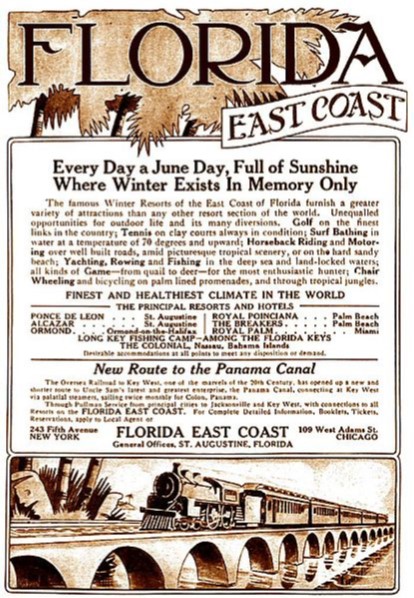 By the close of the 1800’s Flagler’s railroad and hotel investments stretched all the way to the Biscayne Bay, and his business dealings quickly led to the establishment of a small city that the settlers wanted to name Flagler. Touched but unsettled by the name, Flagler instead requested it be named after the local native population, the Mayaimi Indians. Soon after, the desire to establish better international trade due to the opening of the Panama Canal and link his railroad dealings with a deep water port pushed Flagler’s railroad all the way to Key West, which was at the time Florida’s most populated city, with 20,000 people.
By the close of the 1800’s Flagler’s railroad and hotel investments stretched all the way to the Biscayne Bay, and his business dealings quickly led to the establishment of a small city that the settlers wanted to name Flagler. Touched but unsettled by the name, Flagler instead requested it be named after the local native population, the Mayaimi Indians. Soon after, the desire to establish better international trade due to the opening of the Panama Canal and link his railroad dealings with a deep water port pushed Flagler’s railroad all the way to Key West, which was at the time Florida’s most populated city, with 20,000 people.
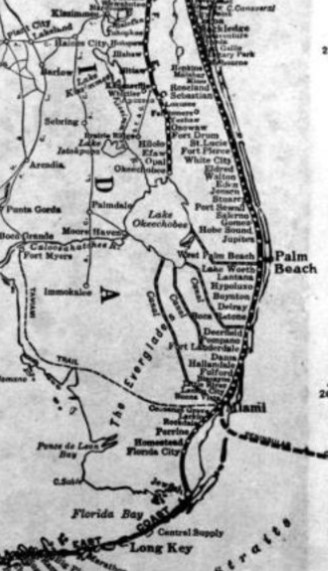 One of the heralds of Flagler’s railroad was his train depots, more than two dozen were built during his life time. The buildings were all constructed from the same set of plans, all painted the same bright yellow, and were only distinguishable by the bright white signage depicting the name of the town you stopped at. Only 8 of the original structures remain, and Jupiter, FL is host to one of the originals, which was built in 1894 and rebuilt in 1915. Jupiter was not considered a premier stop for Flagler’s railroad, but its original depot was almost twice as big as the building that is currently in place at Sawfish Park, catty-corner to the Jupiter Lighthouse. It was built of old-growth pine boards and designed primarily for use as a freight depot, transporting fruit and vegetable freight loads. The building even withstood the flooding, rain and wind damage from the Category 4 hurricane that lashed Palm Beach and much of Florida’s eastern coast in 1949! Some of Jupiter’s earliest living residents remember school trips and local travel through the depot before it’s closure.
One of the heralds of Flagler’s railroad was his train depots, more than two dozen were built during his life time. The buildings were all constructed from the same set of plans, all painted the same bright yellow, and were only distinguishable by the bright white signage depicting the name of the town you stopped at. Only 8 of the original structures remain, and Jupiter, FL is host to one of the originals, which was built in 1894 and rebuilt in 1915. Jupiter was not considered a premier stop for Flagler’s railroad, but its original depot was almost twice as big as the building that is currently in place at Sawfish Park, catty-corner to the Jupiter Lighthouse. It was built of old-growth pine boards and designed primarily for use as a freight depot, transporting fruit and vegetable freight loads. The building even withstood the flooding, rain and wind damage from the Category 4 hurricane that lashed Palm Beach and much of Florida’s eastern coast in 1949! Some of Jupiter’s earliest living residents remember school trips and local travel through the depot before it’s closure.
 The Jupiter Train Depot was in use from 1894 to 1965, and then relocated to Tequesta to be used as a private home by the former publisher of the Beacon News, Betty Bush, after 1966. The depot was retrofitted with the inner workings of a home, including a 5 foot cast iron fireplace, and a wrought iron spiral staircase, and the loading docks were turned into large verandas on her two-acre lot on Seabrook Road. After Bush’s death in 1997 her family lived in the home, and then a caretaker was given residence, but the building fell into disrepair, termites and Florida’s weather had taken its toll. Graffiti an overgrown yard and other issues deemed the building “an eyesore” as violations and fees began to pile up against the empty building. Sadly, it was scheduled for demolition, where the Village of Tequesta planned to use the property as a green space and park. Thankfully, it was saved at the very last minute by Jupiter’s iconic historical preservation committee, the Loxahatchee Guild, it’s rescue was called a miracle by FEC Railroad historian Seth Bramson, in April of 2012.
The Jupiter Train Depot was in use from 1894 to 1965, and then relocated to Tequesta to be used as a private home by the former publisher of the Beacon News, Betty Bush, after 1966. The depot was retrofitted with the inner workings of a home, including a 5 foot cast iron fireplace, and a wrought iron spiral staircase, and the loading docks were turned into large verandas on her two-acre lot on Seabrook Road. After Bush’s death in 1997 her family lived in the home, and then a caretaker was given residence, but the building fell into disrepair, termites and Florida’s weather had taken its toll. Graffiti an overgrown yard and other issues deemed the building “an eyesore” as violations and fees began to pile up against the empty building. Sadly, it was scheduled for demolition, where the Village of Tequesta planned to use the property as a green space and park. Thankfully, it was saved at the very last minute by Jupiter’s iconic historical preservation committee, the Loxahatchee Guild, it’s rescue was called a miracle by FEC Railroad historian Seth Bramson, in April of 2012.
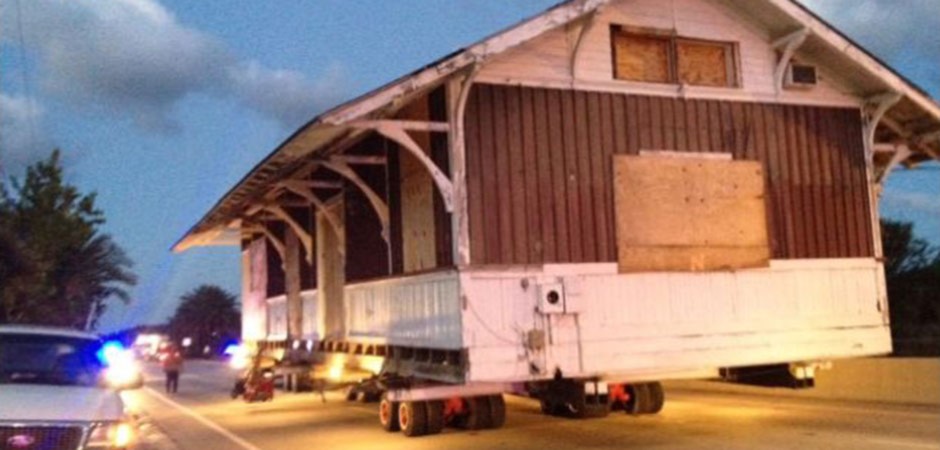 Hand in hand with the Florida East Coast Railway Society and numerous volunteers and donors, the Loxahatchee Guild raised more than $150,000 in its efforts to restore and preserve the existing structure, moving it back from Tequesta into Jupiter in 2012 (under cover of night due to permitting regulations in place at the time) and placing it at the Sawfish Bay park, where it is now serving as a museum and event venue. The 3AM move itself had more than one snag, when a train stopped on the tracks forced an elongated pause in progress, and then an old stone bench and palm tree had to be swiftly removed at its landing site before the early morning deadline!
Hand in hand with the Florida East Coast Railway Society and numerous volunteers and donors, the Loxahatchee Guild raised more than $150,000 in its efforts to restore and preserve the existing structure, moving it back from Tequesta into Jupiter in 2012 (under cover of night due to permitting regulations in place at the time) and placing it at the Sawfish Bay park, where it is now serving as a museum and event venue. The 3AM move itself had more than one snag, when a train stopped on the tracks forced an elongated pause in progress, and then an old stone bench and palm tree had to be swiftly removed at its landing site before the early morning deadline!
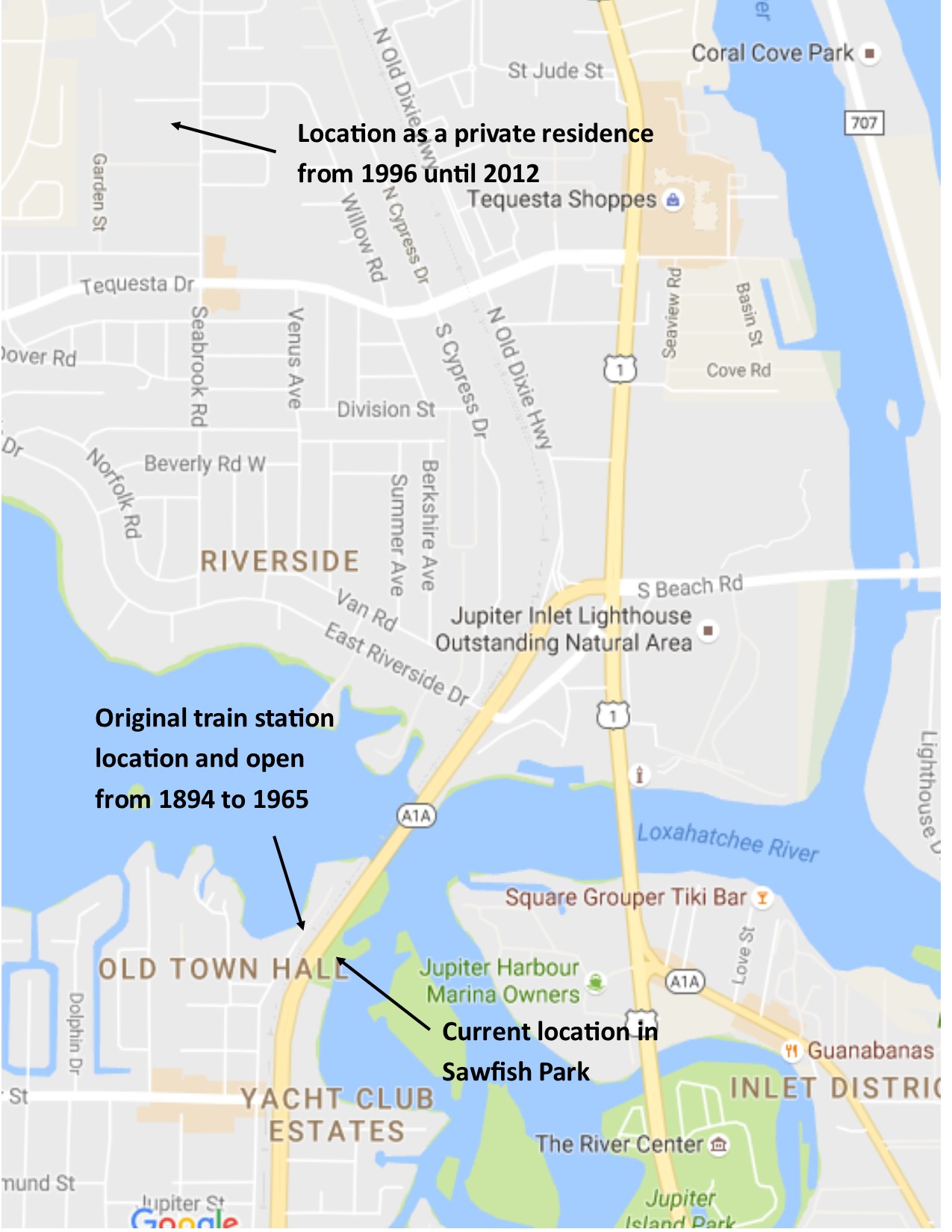 The building has since been completely restored and repainted, the building’s original sunshine yellow, Flagler’s favorite color, shone brightly at the celebration of its 100th anniversary celebration in summer of 2015. Thanks to the generosity of the Loxahatchee Guild and many donors and allies, the building that was once weeks away from a wrecking ball’s demolition now stands with a new roof, new replica windows and doors, and can even be rented for weddings and small events! You can tour the building, and imaging the hustle and bustle of its era, if the timing is right you can even greet staff members wearing period clothing and hoop skirts!
The building has since been completely restored and repainted, the building’s original sunshine yellow, Flagler’s favorite color, shone brightly at the celebration of its 100th anniversary celebration in summer of 2015. Thanks to the generosity of the Loxahatchee Guild and many donors and allies, the building that was once weeks away from a wrecking ball’s demolition now stands with a new roof, new replica windows and doors, and can even be rented for weddings and small events! You can tour the building, and imaging the hustle and bustle of its era, if the timing is right you can even greet staff members wearing period clothing and hoop skirts!
The Jupiter Depot is one of the last standing reminders of one of the fastest growing time periods in Florida’s history. Like the DuBois house and the Jupiter Lighthouse, it stands as a marker of Jupiter’s historical value that people of all ages can appreciate.
Founded in 1981 by Mrs. Anna Laird Minear, the Loxahatchee Guild is a dedicated group of women who work to preserve local history through advocacy and fundraising efforts. For more information and to support the Loxahatchee Guilds work go to:
This email address is being protected from spambots. You need JavaScript enabled to view it.
www.LoxahatcheeGuild.org
Facebook: Loxahatchee Guild
*